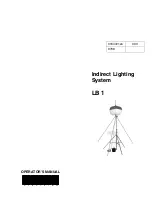
- 11 -
1.4
Safety during use and
operation
1
When the unit has to operate in a fire-hazardous
environment, each engine exhaust has to be
provided with a spark arrester to trap incendiary
sparks.
2
The exhaust contains carbon monoxide which is a
lethal gas. When the unit is used in a confined
space, conduct the engine exhaust to the outside
atmosphere by a pipe of sufficient diameter; do this
in such a way that no extra back pressure is created
for the engine. If necessary, install an extractor.
Observe any existing local regulations.
Make sure that the unit has sufficient air intake for
operation. If necessary, install extra air intake ducts.
3
When operating in a dust-laden atmosphere, place
the unit so that dust is not carried towards it by the
wind. Operation in clean surroundings considerably
extends the intervals for cleaning the air intake
filters and the cores of the coolers.
4
Never remove a filler cap of the cooling water
system of a hot engine. Wait until the engine has
sufficiently cooled down.
5
Never refill fuel while the unit is running, unless
otherwise stated in the Atlas Copco Instruction
Book (AIB). Keep fuel away from hot parts such as
air outlet pipes or the engine exhaust. Do not smoke
when fuelling. When fuelling from an automatic
pump, an earthing cable should be connected to the
unit to discharge static electricity. Never spill nor
leave oil, fuel, coolant or cleansing agent in or
around the unit.
6
All doors shall be shut during operation so as not to
disturb the cooling air flow inside the bodywork
and/or render the silencing less effective. A door
should be kept open for a short period only e.g. for
inspection or adjustment.
7
Periodically carry out maintenance works according
to the maintenance schedule.
8
Stationary housing guards are provided on all
rotating or reciprocating parts not otherwise
protected and which may be hazardous to
personnel. Machinery shall never be put into
operation, when such guards have been removed,
before the guards are securely reinstalled.
9
Noise, even at reasonable levels, can cause irritation
and disturbance which, over a long period of time,
may cause severe injuries to the nervous system of
human beings.
When the sound pressure level, at any point where
personnel normally has to attend, is:
- below 70 dB(A): no action needs to be taken,
- above 70 dB(A): noise-protective devices should
be provided for people continuously being
present in the room,
- below 85 dB(A): no action needs to be taken for
occasional visitors staying a limited time only,
- above 85 dB(A): room to be classified as a noise-
hazardous area and an obvious warning shall be
placed permanently at each entrance to alert
people entering the room, for even relatively
short times, about the need to wear ear
protectors,
- above 95 dB(A): the warning(s) at the
entrance(s) shall be completed with the
recommendation that also occasional visitors
shall wear ear protectors,
- above 105 dB(A): special ear protectors that are
adequate for this noise level and the spectral
composition of the noise shall be provided and a
special warning to that effect shall be placed at
each entrance.
10 The unit has parts of which the temperature can be
in excess of 80 °C (176 °F), and which may be
accidentally touched by personnel when opening
the machine during or just after operation.
Insulation or safety guards protecting these parts
shall not be removed before the parts have cooled
down sufficiently, and must be re-installed before
operating the machine. As it is not possible to
insulate or protect all hot parts by guards (e.g.
exhaust manifold, exhaust turbine), the operator /
service engineer must always be aware not to touch
hot parts when opening a machine door.
11 Never operate the unit in surroundings where there
is a possibility of taking in flammable or toxic
fumes.
12 If the working process produces fumes, dust or
vibration hazards, etc., take the necessary steps to
eliminate the risk of personnel injury.
13 When using compressed air or inert gas to clean
down equipment, do so with caution and use the
appropriate protection, at least safety glasses, for
the operator as well as for any bystander. Do not
apply compressed air or inert gas to your skin or
direct an air or gas stream at people. Never use it to
clean dirt from your clothes.
14 When washing parts in or with a cleaning solvent,
provide the required ventilation and use appropriate
protection such as a breathing filter, safety glasses,
rubber apron and gloves, etc.
00_00_HiLight H4_EN.book Page 11 Monday, April 18, 2016 2:10 PM
Содержание HiLight H4 Kd ESF
Страница 2: ...00_00_HiLight H4_EN book Page 2 Monday April 18 2016 2 10 PM ...
Страница 76: ... 76 10 3 Average illumination versus distance 00_00_HiLight H4_EN book Page 76 Monday April 18 2016 2 10 PM ...
Страница 81: ... 81 Circuit diagrams 00_00_HiLight H4_EN book Page 81 Monday April 18 2016 2 10 PM ...
Страница 85: ... 85 00_00_HiLight H4_EN book Page 85 Monday April 18 2016 2 10 PM ...
Страница 90: ... 90 00_00_HiLight H4_EN book Page 90 Monday April 18 2016 2 10 PM ...
Страница 93: ...00_00_HiLight H4_EN book Page 93 Monday April 18 2016 2 10 PM ...
Страница 94: ......












































